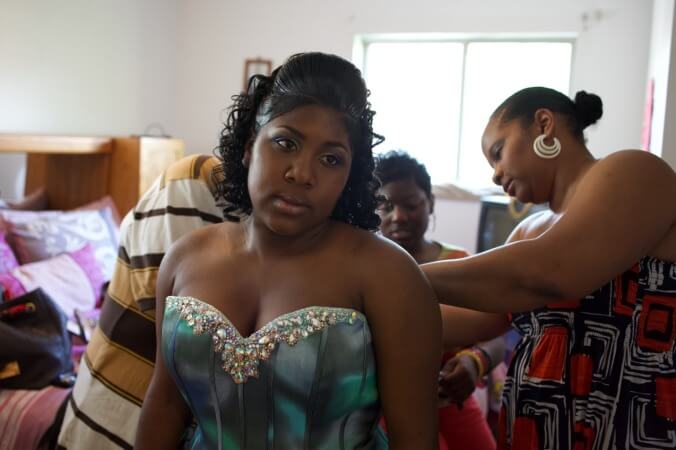Midnight In Paris finds a final hurrah for teenage life in one town’s prom preparations


High school rites of passage have a way of bringing communities together (Friday Night Lights, anyone?), and Midnight In Paris, which follows a group of Michigan teenagers during the five days leading up to their prom, has faith in our nostalgia and empathy. Filmmakers Roni Moore and James Blagden keep their focus narrow, trailing a half-dozen or so members of the class of 2012 as they hype themselves up for the big event, show off their outfits, and roll their eyes at their parents’ concerns about drinking and drugs. All of this will be recognizable and relatable to American viewers, and the subjects’ enthusiasm is infectious. But that jubilance only lasts so long, and how Midnight In Paris rather suddenly runs out of steam after prom night leaves unanswered questions about the teens we see celebrating the end of their high school years.
Shot in Flint, Michigan, in May 2012 (four years before revelations about Flint’s poisoned water would become national news—a development that gets not so much as a post-script mention in the film), Midnight In Paris makes its intentions clear from the start: This will be a positive depiction of the teens, the high school, their families, and the city. “Everybody always looks at the bad stuff that goes on here,” one kid laments as Moore and Blagden introduce Flint with decaying store signs, boarded-up structures, and weather-beaten portraits of Martin Luther King Jr. and Malcolm X painted on a brick building fallen into disrepair. They wish someone would show the side of Flint that is encouraging and enthusiastic—“the kids that are actually doing something”—and Midnight In Paris takes that desire as its mission statement.
The narrowed perspective is mostly an asset. While wandering Flint Northern High School, home of the Vikings, Moore and Blagden talk to teachers and administrators about the prom, and then approach students to ask about their plans. Certain patterns emerge: Most pairs are going as friends; there is a recurring concern with matching color schemes; and older relatives’ vehicles—an uncle’s BMW, a tricked-out Cadillac—are being borrowed for the big night. With a mixture of braggadocio and amusement, some young men list off their needs for the evening (alcohol, weed, condoms, numerous hookups), while others lament how much everything costs. Meanwhile, young women uniformly complain about the expectation of sex, instead channeling their excitement into getting glammed up. In back-to-back scenes, one girl dryly says, “It seems like it’ll be fun. You get to leave your house, so there’s that,” while a young man jokes about sneaking in a “twerk whistle.” It’s a somewhat predictable heteronormative gender divide, confirmed when parents are pulled into the mix—one older female relative sternly tells her younger loved ones to watch their drinks—but never questioned by the film itself.
Although Midnight In Paris frustratingly rejects lower-third graphics to identify the teens, a few get more screen time; although you might not catch their names until midway through, they’re clearly meant to be the primary focus. There’s soft-spoken Maurquisha, who comes alive while leading step team practice, loves Full House because of its wholesomeness, and lives with her father. There’s Jermaine, who goes on hunting and fishing trips with his dad. And there’s Henry, who rolls his eyes when his mother warns him against smoking weed because it could lead to bath salts. (Her offended “Hey, I be looking at the news!” is one of the film’s funniest moments.)
Moore and Blagden use the teens’ gender divide and their (often loving) friction with their parents to work some humor in, while also expanding their focus to explore how the entire neighborhood becomes involved in the prom planning. A local woman who runs a dress give-away speaks frankly about the fulfillment she feels after helping a young woman find the perfect gown amid the donations. Henry’s cousin, who owns a car wash, provides the seniors with free services so their ride will be ready for the big night. And when prom arrives, the seniors are flanked by dozens of family members—in one scene, what looks to be everyone on the block lines the sidewalks—to marvel at their black-tie attire, snap cellphone pictures, and wish them well.
That all contributes to a heartwarming sense of investment in these teens and their happiness, and Midnight In Paris has a celebratory atmosphere. But the documentary is held back by Moore and Blagden’s lack of follow-up questions. Although the teens splinter off to various after parties, we see only one of them. Is that because the ensuing drug use and Taco Bell binging is so counter to what the seniors had excitedly anticipated doing? Are Moore and Blagden making a point about the gap between expectation and reality? It’s possible, but because no teens are interviewed after the prom about how they think the night went, the documentary ends surprisingly abruptly. Without any final words from Maurquisha or any of the documentary’s other featured young women, Midnight In Paris feels curiously unfinished.
The flubbed ending is more glaring because the film is otherwise so enjoyable and relatable. It’s achingly familiar in its exploration of what seems to the seniors like a final dash toward adulthood and its accompanying freedoms. “The past is gone,” reads Flint Northern’s commemorative class of 2012 T-shirt, and the joy and anxiety Midnight In Paris finds in high school’s last days is a reminder that some things never really change.